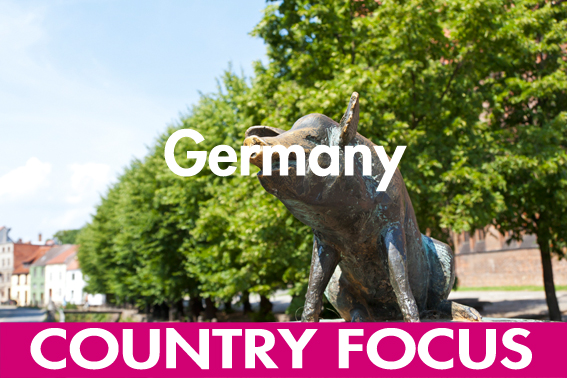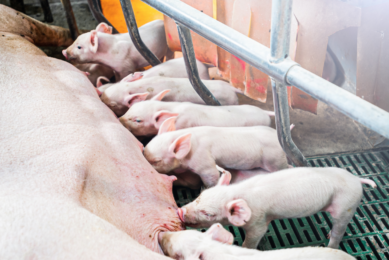Can Germany’s pig industry still smile?

Since 2000, Germany’s pig meat production and pig meat exports have shown a remarkable dynamic. Most recent developments seem to indicate, however, the end of a boom phase. This overview analyses both growth as well as the present situation.
Between 2000 and 2012, German pig meat production increased from 3.9 million tonnes to 5.0 million tonnes or by 29% (Figure 1). The growth rates were especially high between 2006 and 2012, when the production volume increased by 751,000 tonnes. This remarkable growth was, however, not only based on domestic pig production but also on the imports of piglets and slaughter pigs from Denmark and the Netherlands. About 9 million piglets and nearly 5 million slaughter pigs were imported per year, a considerable risk not only for the pig farmers in north-western Germany but also for the slaughterhouses. Without these imports they would not have been able to run their facilities to full capacity.
In the same time period, hog slaughter grew from 43.2 million to 58.4 million and even slightly increased in 2013. Here, the fastest growth with 8.5 million hogs can be observed between 2006 and 2010. From then on, the number of slaughtered hogs stagnated (Figure 2 ).
Parallel to the remarkable growth of hog slaughter and pig meat production, the export volume of live pigs, pig meat and products increased constantly until 2013 and made Germany the leading exporting country before the US and Denmark (Figure 3). In the analysed time period exports grew by over 1.8 million tonnes or by 283%, between 2006 and 2008 alone by 600,000 tonnes. Parallel to this remarkable growth, the Danish, Dutch and US pig meat exports either stagnated or even decreased.
EU dominates
In exports and imports, trade relations with EU member countries dominated. In 2013, 74.0% of all exports were delivered to an EU member country and even 97.2% of imports came from such a country.
A closer look at the trade flows reveals that eight of the ten leading countries of destination were located in Europe and two in East Asia (Figure 4). Italy and the Netherlands were the two most important markets for German exporting companies, followed by Poland and China. Besides Poland, also the Russian Federation and the Czech Republic were important importing countries in Eastern Europe. Taking China and Hong Kong as one market, exports would be as high as 317,300 tonnes which would rank them as number 3. With over 182,000 tonnes or 6.5% of the overall export volume the Russian Federation was a major market, especially for lower value products.
The regional concentration of pig meat imports by Germany is much higher as can be seen from the data in Figure 5. Denmark, Belgium and the Netherlands contributed 71.0% to the German imports. Poland is the only major country of origin in Eastern Europe and Switzerland the only non-EU country among the top ten exporting countries to Germany.
A closer look at the development of the balance of trade with pig meat shows (Table 6) that the surplus grew from almost 787,000 tonnes in 2006 to 1.6 million tonnes in the first three years of the present decade.
A detailed analysis of the dynamics between 2010 and 2013 reveals that the production volume after years of continuous increase entered a phase of stagnation with about 5 million tonnes. This is also reflected in the number of slaughtered pigs which hovered around 58 million. Exports also no longer increased from 2012 onwards. The balance of trade also stagnated from 2011 on around 1.6 million tonnes. All this indicates that the boom phase has come to an end which raises the question of whether the German swine industry will be able to stop this trend and initiate years of further growth. To answer this question, one has to look at the most recent development in the first half of 2014.
And the future?
Between November 2013 and May 2014, the number of pig farms in Germany decreased from 27,900 to 27,100 or by 2.9%. The inventory of finishing pigs fell by 2.8%, and the number of slaughtered hogs by 2%. In contrast, the number of sows grew by 1.1% and that of piglets (< 20 kg) by 0.5% according to data supplied by the German Federal Statistics Office (Destatis). The difference between the dynamics in finishing pigs and sows inventory is a result of the decreasing piglet and slaughter pig imports from Denmark and the Netherlands. In Denmark, the swine industry has stabilised which is documented by rising export figures. This had impacts on the exports of live pigs. In the Netherlands, the downward trend in pig meat production and exports could not yet be stopped.
It is difficult to predict what the impact of the ban will be on pig meat imports by the Russian Federation, the dissemination of Porcine Epidemic Diarrhoea (PED) in the US since May 2013 and the expected higher imports by China on the German and the EU swine industries. Latest data by Destatis show that pig meat exports to the Russian Federation fell by 90,000 tonnes between January and end of May in 2014 compared to 2013. As no new markets could be developed within a short time, total exports decreased by 12.5%. This is one reason for the lasting low prices for slaughter pigs not only in Germany but also in the other major pig producing countries in the EU. It is still an open question whether US pig meat export will fall considerably because of the declining production. This could be the case as the lower production has already caused rising domestic prices which make exports less attractive which could initiate an upward trend in pig meat exports by EU member countries. This may also be supported by higher Chinese imports which are expected for the second half of 2014 because of the widening gap between the growing demand and domestic production. This may be a glimmer of hope after years of lasting low prices and economic problems for pig farmers.
Article featured in Pig Progress 30.8, 2014
References are available on request.
The author is professor emeritus and scientific director of the Science and Information Centre for Sustainable Poultry Production, University of Vechta, Germany. hwindhorst@wing.uni-vechta.de

Germany cracking down on antibiotics
After an earlier, unsuccessful attempt in 2008, Germany made serious work of antibiotic usage reduction in April 2014, when a new, compulsory monitoring system was introduced in the livestock industry. The system, called German Antibiotics Resistance Strategy (DART), implies that every six months, pig, poultry and cattle farmers have to report their antibiotic usage to the veterinary authorities. Should these data show a higher-than-average usage, then producers are forced to cooperate with a vet to compose an improvement plan for reduction of antibiotic usage. Farms using over 25% above average, should even present a written action plan, with financial penalties looming in case the plan is not followed. In addition, the producers can compare their antibiotic usage through an online system.
Agreeing on and implementing the new system took a long time in the German parliament, called Bundestag. It does show, however, that the country is serious in aiming to reduce antibiotic usage. Earlier data showed that the use of antibiotics in the German animal production declined in 2013. With the new efforts, it is expected that trend will continue.The German initiative follows the European Union-wide ban on the usage of antibiotics as growth promoters in animal feed in 2006. Since then, several European countries have also actively started to work on better monitoring of antibiotics given by veterinarians – trying to reduce even therapeutic usage of antibiotics. The system used in the Netherlands inspired the system that has now become in use in Germany as well.
Photo caption: German pork producers are now also urged by law to reduce the usage of antibiotics.











